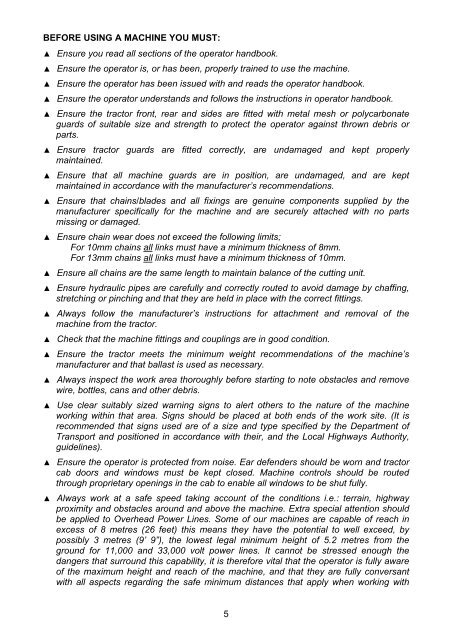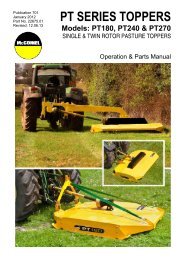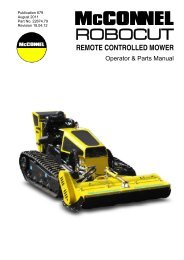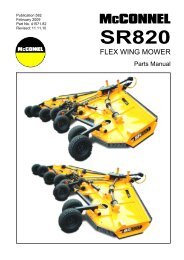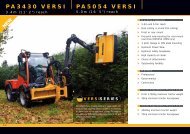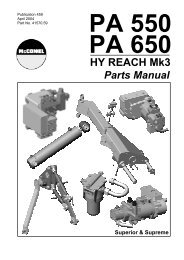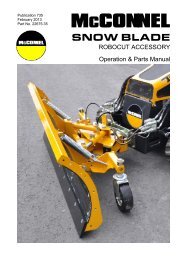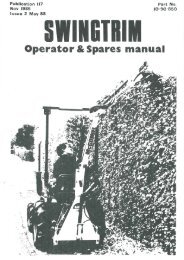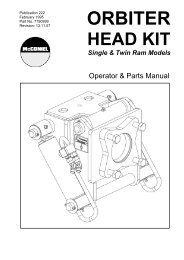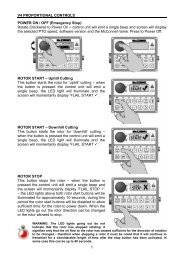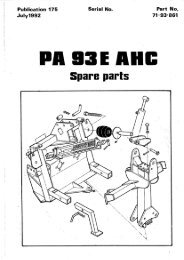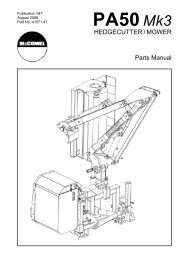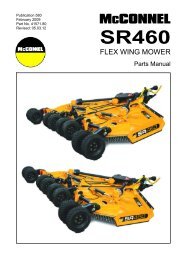1.2m & 1.5m Rotary Head (Heavy Duty) - McConnel
1.2m & 1.5m Rotary Head (Heavy Duty) - McConnel
1.2m & 1.5m Rotary Head (Heavy Duty) - McConnel
You also want an ePaper? Increase the reach of your titles
YUMPU automatically turns print PDFs into web optimized ePapers that Google loves.
BEFORE USING A MACHINE YOU MUST:<br />
▲ Ensure you read all sections of the operator handbook.<br />
▲ Ensure the operator is, or has been, properly trained to use the machine.<br />
▲ Ensure the operator has been issued with and reads the operator handbook.<br />
▲ Ensure the operator understands and follows the instructions in operator handbook.<br />
▲ Ensure the tractor front, rear and sides are fitted with metal mesh or polycarbonate<br />
guards of suitable size and strength to protect the operator against thrown debris or<br />
parts.<br />
▲ Ensure tractor guards are fitted correctly, are undamaged and kept properly<br />
maintained.<br />
▲ Ensure that all machine guards are in position, are undamaged, and are kept<br />
maintained in accordance with the manufacturer’s recommendations.<br />
▲ Ensure that chains/blades and all fixings are genuine components supplied by the<br />
manufacturer specifically for the machine and are securely attached with no parts<br />
missing or damaged.<br />
▲ Ensure chain wear does not exceed the following limits;<br />
For 10mm chains all links must have a minimum thickness of 8mm.<br />
For 13mm chains all links must have a minimum thickness of 10mm.<br />
▲ Ensure all chains are the same length to maintain balance of the cutting unit.<br />
▲ Ensure hydraulic pipes are carefully and correctly routed to avoid damage by chaffing,<br />
stretching or pinching and that they are held in place with the correct fittings.<br />
▲ Always follow the manufacturer’s instructions for attachment and removal of the<br />
machine from the tractor.<br />
▲ Check that the machine fittings and couplings are in good condition.<br />
▲ Ensure the tractor meets the minimum weight recommendations of the machine’s<br />
manufacturer and that ballast is used as necessary.<br />
▲ Always inspect the work area thoroughly before starting to note obstacles and remove<br />
wire, bottles, cans and other debris.<br />
▲ Use clear suitably sized warning signs to alert others to the nature of the machine<br />
working within that area. Signs should be placed at both ends of the work site. (It is<br />
recommended that signs used are of a size and type specified by the Department of<br />
Transport and positioned in accordance with their, and the Local Highways Authority,<br />
guidelines).<br />
▲ Ensure the operator is protected from noise. Ear defenders should be worn and tractor<br />
cab doors and windows must be kept closed. Machine controls should be routed<br />
through proprietary openings in the cab to enable all windows to be shut fully.<br />
▲ Always work at a safe speed taking account of the conditions i.e.: terrain, highway<br />
proximity and obstacles around and above the machine. Extra special attention should<br />
be applied to Overhead Power Lines. Some of our machines are capable of reach in<br />
excess of 8 metres (26 feet) this means they have the potential to well exceed, by<br />
possibly 3 metres (9’ 9”), the lowest legal minimum height of 5.2 metres from the<br />
ground for 11,000 and 33,000 volt power lines. It cannot be stressed enough the<br />
dangers that surround this capability, it is therefore vital that the operator is fully aware<br />
of the maximum height and reach of the machine, and that they are fully conversant<br />
with all aspects regarding the safe minimum distances that apply when working with<br />
5


